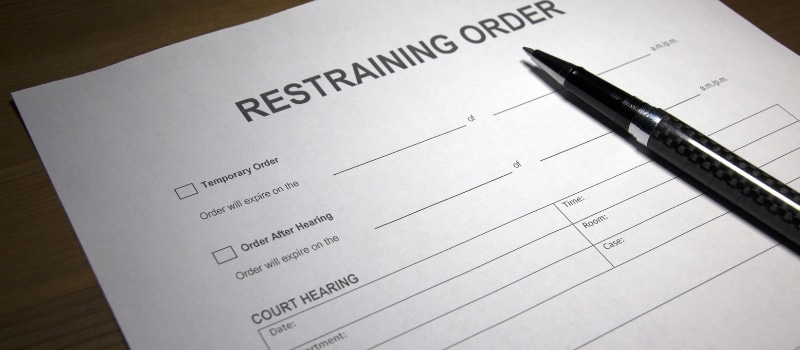Restraining orders for family law matters are used for different purposes in different states. In Texas, people often confuse restraining orders with protective orders, but these two types of orders are used for very different purposes. If you want to know how to get a restraining order removed in Texas, you should first figure out whether you actually need to remove a restraining order or a protective order.
Since you may be reading this because you actually want to find out how to get a protective order removed (vs. how to remove a restraining order), we’ll cover how to fight a protective order in Texas in this post. If you want to learn more about restraining orders and how to remove a restraining order, check out our how to file a restraining order in Texas page.
What is a restraining order in Texas?
When people hear the words “restraining order,” they often assume restraining orders are strictly used for vindictive purposes (which is why so many people Google “how do I remove a restraining order” when a more restrictive protective order may be at issue instead). In reality, restraining orders might be better described as “play nice until you get to court” orders.
Temporary restraining orders (TROs) are generally filed in the majority of Texas family law cases to preserve the status quo and make sure the parties play by the rules during a divorce or custody case. For example, the courts do not want the parties to remove a bunch of money from a bank account the moment they are served with divorce papers. They put injunctions in place through a TRO to ensure that nothing significant changes or happens before a court can hear the evidence and issue an order (or an agreement is reached).
Some counties in Texas, Dallas County for example, automatically include injunctions (that basically act as a TRO) in their standing orders for divorce and child custody cases. Since maintaining the status quo is generally the objective with TROs and standing orders, it’s rare that a party would need to figure out how to beat a restraining order or how to remove a restraining order in Texas.
Restraining orders can stipulate a number of things pertaining to a pending divorce. These stipulations may include how the parties are expected to handle marital funds, and they usually direct the parties to fully disclose what assets are included in the marital estate. As noted above, restraining orders can also prohibit the parties from spending excessive amounts of community funds or incurring unnecessary debt.
Other “play nice” (and common sense) directives found in restraining orders may include ordering the parties to refrain from harassing or disparaging each other, drinking while in possession of the children, hiding or secreting the children and so on. In most cases, restraining orders won’t exclude a party from a couple’s residence until the court decides who gets to stay there.
Can you remove a restraining order in Texas?
Since restraining orders are generally temporary in Texas, it’s very unlikely anyone would ever need to know how to remove a restraining order. A court will issue a TRO that expires by operation of law for 14 days, which is why most Temporary Orders end within the first two weeks of a petition being filed. It may be extended but will not extend past 28 days. The TRO does not last the pendency of the case (injunctions can but not the TRO), so fighting a restraining order usually isn’t an issue in Texas.
Restraining order removal just isn’t something you see occurring in family law cases. Instead of removing a restraining order, what generally happens is temporary orders either go away once temporary orders are entered, or they just expire.
Instead of removing a restraining order, what generally happens is that these injunctions become temporary injunctions and are included in the Temporary Orders by the Court, or they can just expire if the party seeking a TRO doesn’t proceed with an evidentiary hearing.
In cases where one of the parties is not abiding by the directives of the restraining order or doing something to jeopardize the marital estate, the other party could take steps necessary for enforcing a court order.
For example, if a couple owns a business together, the couple’s temporary restraining orders should include directives for the continued operation of the business. If one party tries to take advantage of the situation for their personal benefit (or out of spite for the other party), the court could include injunctions in the temporary orders that are entered following the TRO. These injunctions could include directives that tighten up that party’s ability to write checks, sell assets, incur debt, use credit cards and so on.
What is a protective order used for in Texas?
In Texas family law cases, protective orders usually deal with cases pertaining to family violence where some form of dating or marital relationship existed (or exists) and whereby family violence has occurred in the past and is likely to occur in the future.
Consequently, if you’re wondering how to get a domestic violence restraining order removed in Texas, it may be a protective order you need to address instead. However, in cases involving domestic violence, parties may also request an emergency ex parte TRO that provides expedient and extraordinary relief before the parties can get to court to secure a protective order.
If you have been accused of domestic violence and are the subject of an ex parte TRO, you will have the opportunity to appear in court and plead your case within 14 days after the ex parte order is issued.
Protective orders may also be issued in cases where a party is stalking or harassing someone, whether that person was in a past relationship with the accused stalker or harasser, or not. The courts may also grant protective orders to victims of human trafficking who need protection from traffickers and their associates.
Emergency protective orders (EPOs) can also be requested in cases of family violence, sexual assault or stalking. Unlike “standard” protective orders, emergency protective orders are only used on a short-term basis (they last between 31 and 91 days, depending on the situation).
What can be included in a protective order in Texas?
Compared to restraining orders, which are generally designed to be preventive, protective orders can be both preventive and protective in nature. Depending on the circumstances, protective orders in Texas may prohibit a party from certain actions, which may include:
- Harming, threatening or harassing the protected person or their children (both directly and through other individuals).
- Going to or being within a certain distance of the protected person or their family, place of residence, workplace or child’s school or daycare.
- Harming threatening or otherwise interfering with a pet, companion animal or assistance animal that is cared for by the protected person.
- Carrying a firearm (even if the abuser is licensed to carry), unless the party is a peace officer.
- Transferring, encumbering or disposing of property mutually owned by the protected person and the subject of the protective order.
At their discretion, judges can place other restrictions on an individual (like restricting child custody and visitation) or order the subject of the order to take certain actions. This is a major difference between restraining orders and protective orders. Restraining orders can only take defensive action, whereas protective orders can take affirmative action.
For example, a judge could order the party to get drug tested, go through substance abuse and/or anger management counseling or pay child support, medical or legal bills. Judges can also authorize kick-out orders to force the subject of an emergency ex parte order or protective order to vacate the family residence.
Protective orders in Texas have more teeth to them than restraining orders do. The police typically won’t get involved when a restraining order has been violated (those issues generally need to be addressed in court) but the police can get involved and arrest someone who violates a protective order.
And unlike restraining orders, which tend to be temporary in nature, protective orders often last up to two years, following an evidentiary hearing prompted by an emergency protective order. However, a judge can extend a protective order—even up to a lifetime—depending on the nature of the situation.
How do you get a protective order removed in Texas?
If you actually ARE wondering how can I get a protective order removed (NOT how can I remove a restraining order), start by referring back to the protective order in question. Protective orders include specific statutory requirements regarding when an issue pertaining to the order or a motion to dissolve protective order Texas can be brought before the court.
If a party wants to know how to fight a protective order in Texas because they believe the order of protection was based on false allegations, it’s best to speak with an attorney about how to get a protective order dropped in Texas. A judge will only agree to hear a motion to vacate protective order Texas if the subject of the order can provide clear and convincing evidence that the order was put in place based on false claims.
Protective orders may also stipulate whether or not the order can be modified and what provisions may be subject to modification. A modification may be warranted if the subject of a protective order is granted visitation with his or her child. For example, instead of fling a motion to dismiss protective order Texas, the party may ask to add or change provisions regarding when he or she can pick up and drop off their child and/or be in the same presence of or a certain distance from the protected party and the child.
On the other hand, some protective orders remain in effect for life. If the subject of protection will not agree to have the protective order removed, the party who is the subject of the order must continue to abide by the stipulations contained in the protective order or face the consequences. Violating a protective order can escalate to felony status and come with heavy penalties, including jail time.
Have questions about restraining orders or how to fight a protective order in Texas?
If you live in the Dallas / Fort Worth Metroplex and have questions beyond can a protective or restraining order be removed or want to know how to get a protective order dropped due to false allegations, the family law attorneys at the Sisemore Law Firm are here to help. To schedule a confidential consultation with an attorney at our firm, please call (817) 336-4444 or connect with us online.




